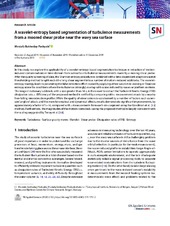A wavelet-entropy based segmentation of turbulence measurements from a moored shear probe near the wavy sea surface
Peer reviewed, Journal article
Published version

Åpne
Permanent lenke
https://hdl.handle.net/1956/22023Utgivelsesdato
2019-12-17Metadata
Vis full innførselSamlinger
- Geophysical Institute [1198]
Originalversjon
https://doi.org/10.1007/s42452-019-1751-2Sammendrag
In this study, we explore the applicability of a wavelet-entropy based segmentation technique in reduction of motion-induced contaminations in time-domain from subsurface turbulence measurements made by a moving shear probe. After the quality screening of data, the Shannon entropy procedure is combined with a time-dependent adaptive wavelet thresholding method to split each 60-s long shear segment into a number of motion-reduced subblocks. The wavelet-entropy strategy leads to preventing the false detection effect caused by applying either wavelet de-noising or Shannon entropy alone for conditions where the turbulence (strongly) overlap with scales induced by waves or platform motions. The longest stationary subblock, with a size greater than 16-s, is then used to extract the Turbulent Kinetic Energy (TKE) dissipation rate, ε. Efficiency of the proposed method is verified by comparing with ε measurements made by a nearby free-falling microstructure profiler. While the quality of observations is constrained by a number of factors such as sensors’ angle of attack, and the wave kinematical and dynamical effects, results demonstrate significant improvements, by approximately a factor of 5–10, compared with ε measurements from each 60-s segment using the Goodman et al. [13] method. Furthermore, the magnitudes of the motion-corrected ε using the proposed method is largely consistent with the scaling suggested by Terray et al. [30].
